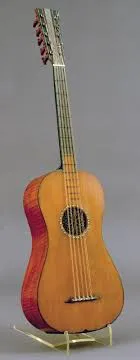1700’s Guitar
In the world of musical instruments, the guitar occupies a special place. Its history spans centuries of creative development, and the 18th century was no exception. During this time, the guitar underwent significant changes, shaping the fundamentals of sound and design that we are used to seeing in modern instruments.
Evolution of sound

During the 18th century, the guitar went through a period of intense development in sound architecture. Instead of using the traditional attachment of strings to the instrument, craftsmen of the time began experimenting with different materials and designs to improve the sound quality.
One of the most significant changes was the introduction of metal strings. This transition led to a brighter and more penetrating sound, allowing the guitar to take its place as a solo instrument on the concert stage.
Design innovations
In addition to improvements in sound, the 18th century also brought significant changes in guitar design. Previously, guitars had been modest in size and simple in shape, but at this time, more complex and graceful models emerged.
One of the most significant innovations was the introduction of curved tops and bottoms, which increased the volume and resonance of the instrument. It also helped improve sound projection, which was important for performance in large halls.
Role in musical culture
The 18th century guitar played a significant role in the musical culture of its time. It was a popular choice among both the aristocracy and the common people. Many composers of the time, such as Fernando Sor and Mauro Giuliani, created works specifically for the guitar, which contributed to its spread and popularization.
Examples of 18th century guitars
Grisman Guitar (1740)
- This guitar, created by the German craftsman Grismann, is one of the oldest known examples.
- It has a maple body decorated with carved patterns and mother-of-pearl inlays.
- The fingerboard is shorter and wider than modern guitars, with gut fret.
- The sound of this guitar is soft, velvety and rich in overtones.
Stradivarius “La Griega” guitar (1700)
- This guitar, created by the famous master Antonio Stradivari, is one of the most valuable guitars in the world.
- It has a pear wood body decorated with carved patterns and mother-of-pearl inlays.
- The fingerboard of this guitar is also decorated with carvings.
- The sound of this guitar is clear, tinkling and full of overtones.
Louis Beauman’s guitar (1730)
- This guitar made by French craftsman Louis Beauman is known for its rich decoration.
- It has a maple body decorated with carved patterns and mother-of-pearl inlays.
- The fingerboard of this guitar is also decorated with carvings.
- The sound of this guitar is soft, velvety and rich in overtones.
Guitar from the Howard Weiler Collection (1750)
- This guitar, featured in the Howard Weiler Collection, is one of the best-preserved examples of guitars from the 1700s.
- It has a fruitwood body decorated with carved patterns.
- The fingerboard of this guitar is simple, with no embellishments.
- The sound of this guitar is soft, velvety and rich in overtones.
Conclusion
The 18th century was a period of important changes and innovations for the guitar. Its sound and design evolved, opening up new possibilities for musicians and inspiring composers. And while technologies and styles may change, the contributions of this time remain forever inscribed in the history of this amazing instrument.
-
What is a feature of 18th century guitar modification?
One of the most significant changes was the introduction of metal strings and the introduction of curved upper and lower parts, which increased the volume and resonance of the instrument. This also helped to improve sound projection, which was important for performances in large halls.
-
When the Howard Weiler guitar was created?
Howard Weiler guitar was created in 1750.
-
Which 18th century composers wrote works for the guitar?
Fernando Sor and Mauro Giuliani, created works specifically for the guitar, which contributed to its dissemination and popularisation.

